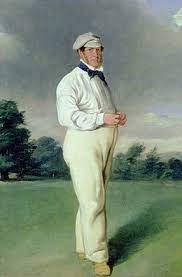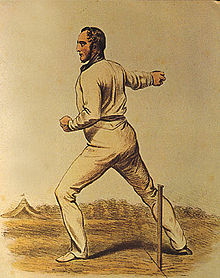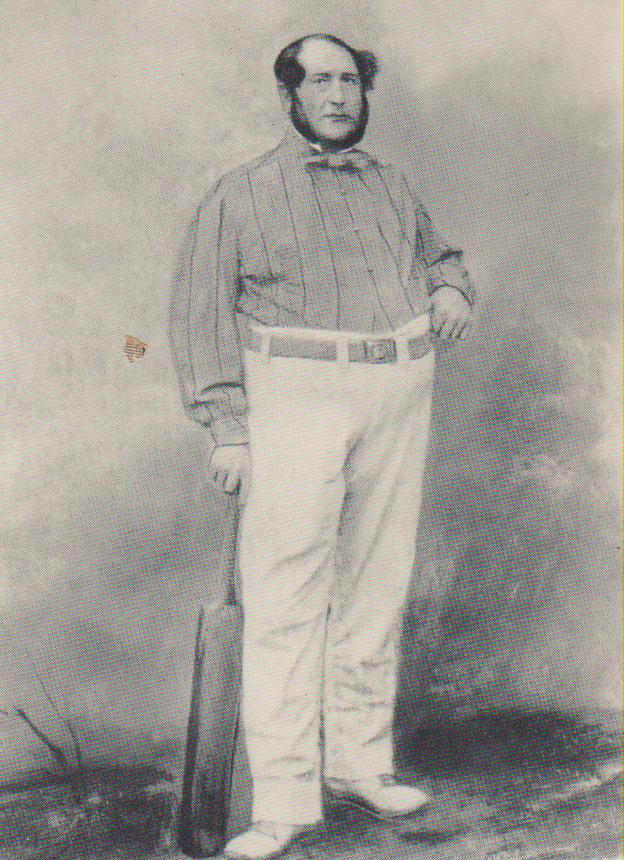Alfred Mynn – The Lion of Kent

On 7th and 8th July 1834, a match was played at Lord’s, billed as England versus Kent. England won the game in a canter, by eight wickets. The Kent team contained several players who are still known as giants of the early years of cricket in the county, but they were no match for England, led by Fred Lillywhite. Kent were dismissed for 21 in their first innings, to which England replied with 61. Kent’s second innings was better – 72 all out – but it took England little time to score the 33 runs they needed for victory.
The real significance of this game was not so much the size of the defeat, but that it was the first time that Alfred Mynn had played for a team described as Kent, and it was one of the last games that Herbert Jenner played for Kent. Thus the baton was passed. Interestingly, that match featured another giant of Kent’s superb early Victorian team, Fuller Pilch, although he was playing for England this time.
Alfred Mynn was a giant of Kent cricket in all ways. Lord Harris described him as six feet one tall, and his average weight when playing was from 18 to 20 stones. He became known as ‘The Lion Of Kent’ and as an article to celebrate the centenary of Mynn’s birth observed, he ‘was no believer in canary-bird diet. ‘Beef and Beer’ was what he declared to be his sustenance on the field, and when asked what else he took, ‘Beer and Beef’ was his answer’.
Mynn was born in Goudhurst on 19th January 1807, and was taught the basics of cricket by local landowner John Willes. As he grew, he became a much feared fast bowler and an extremely capable batsman. His round-arm bowling was, in his early years, not particularly accurate, but that made it all the more dangerous, because among his less than lethal deliveries would be the occasional ripper that no batsman of his day could do anything about. As his experience grew, so did his accuracy and by the end of his career he was acknowledged as the greatest all-rounder of his time, the natural predecessor of WG Grace. His batting, too, was among the best of his era. Probably his friend and team-mate Fuller Pilch could be ranked higher, but he was an essential part of the Kent side for a quarter of a century until 1859.
Kent at this time was undoubtedly the strongest of the county sides, and as the humourist William Prowse noted:
‘With five such mighty cricketers ‘twas but natural to win/ As Felix, Wenman, Hillyer, Fuller Pilch and Alfred Mynn.’

In 1835, as Mynn was establishing his reputation, the Beverley Club was formed in Canterbury, and the control of cricket was slowly passing from the rich benefactors of the previous century to the local clubs, and in due course, to the county clubs. In 1842, the first Canterbury Week was held. What was originally seen as an opportunity for the Beverley Club to make some money and to enjoy the city at the height of the summer, quickly became the focus of the cricketing and social year within the county. This was obviously partly due to the fact that the Kent side was very strong at this time, so the Week provided an opportunity for cricket fans to see the best players in the country in action. It was also an opportunity for people to gamble on the outcome. In the late eighteenth century and early nineteenth century, horse racing at Barham Downs near Canterbury was very popular, but from the 1830s, the race meetings became more and more infrequent, and there was no focus for the gentry nor the commoners down on holiday from the capital to enjoy themselves en masse. Canterbury Cricket Week, in its own way, began to fill that gap, both as a spectacle and as an event to bet on. At the end of the 1842 season, the Beverley Club reformed themselves as the Kent Cricket Club, a short-lived venture as it turned out, but the first attempt to create a county-wide club.
The first time Alfred Mynn played an important match in Canterbury was at the Beverley Ground in 1841. Kent played England and were beaten by 74 runs, but Mynn took eleven wickets and opened the batting with his brother Walter. Fuller Pilch, Ted Wenman, William Hillyer and William Martingell were among the famous names in the Kent side, men who would build their reputation and that of the county over the next twenty years or so.
The statistics of Mynn’s career are very impressive. A batting average of 13.42 and only one hundred to his name might not seem particularly impressive, but centuries were hard to come by in those days of poorly prepared wickets, and his 1038 wickets at 10.33, along with 125 catches show the value of this giant of a man to his side. We could add that his bulk was such that he was not very quick between the wickets, and he was run out in a remarkably high proportion of his innings.
As a bowler, he was peerless in his era, and not until WG Grace came along, three years after Mynn had died, was there anybody to challenge him as an all-round cricketer. His bowling was round-arm, fast and very accurate: he must have been a real terror on the wickets of the time.
Mynn played for a number of teams besides those who boasted the name of Kent. He played for the Gentlemen against the Players many times from 1832, and he was one of the original members of William Clarke’s All England XI, a commercial venture put together in 1846. Mynn was a very popular member of every team he played for, and not just because he brought runs and wickets with him.
When Mynn died, after a short illness, aged only 54, WJ Prowse wrote these lines which still echo through the history of Kent cricket:
“With his tall and stately presence, with his nobly moulded form,
His broad hand-’twas ever open! his brave heart-’twas ever warm!
All were proud of him, all loved him! and as the changing seasons pass
As our Champion lies a-sleeping underneath the Kentish grass;
Proudly, sadly we will name him – to forget him were a sin;
Lightly lie the turf upon thee, kind and manly Alfred Mynn!”

0 Comments